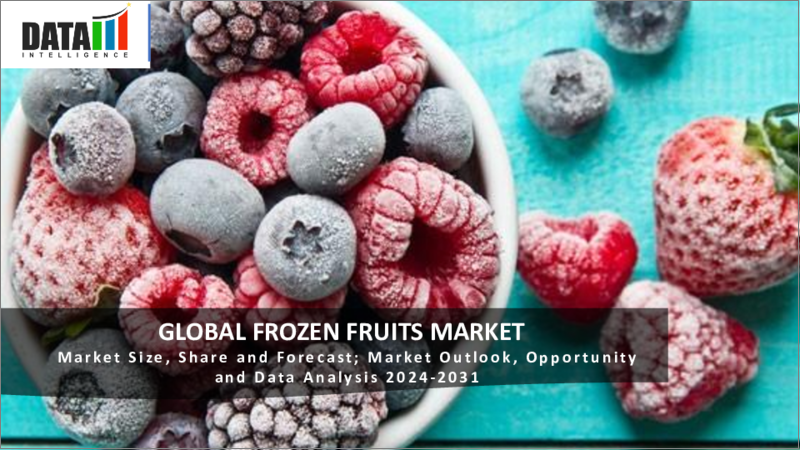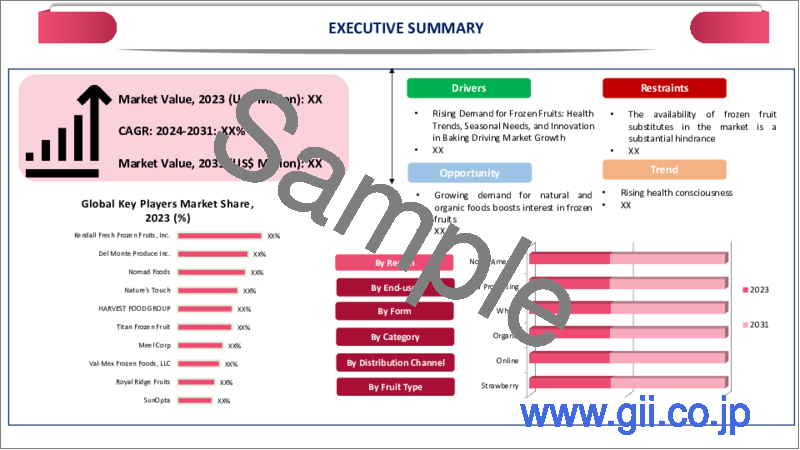|
|
市場調査レポート
商品コード
1290379
冷凍フルーツの世界市場-2023-2030Global Frozen Fruits Market - 2023-2030 |
||||||
カスタマイズ可能
適宜更新あり
|
|||||||
| 冷凍フルーツの世界市場-2023-2030 |
|
出版日: 2023年06月12日
発行: DataM Intelligence
ページ情報: 英文 195 Pages
納期: 即日から翌営業日
|
- 全表示
- 概要
- 目次
市場の概要
世界の冷凍フルーツ市場は、2022年に39億5,740万米ドルに達し、2030年には65億4,940万米ドルにまで達し、有利な成長が予測されます。同市場は予測期間中(2023年~2030年)、CAGR6.5%で成長しています。
冷凍フルーツの需要は、健康志向の高い消費者の間で、健全で健康的なスナックを採用する人気が高まっていることや、消費者が新鮮なフルーツベースの製品を消費する傾向を強めていることが要因となっています。冷凍ブルーベリー100gには、約57カロリー、0.3g脂肪、14g炭水化物、2.4g繊維、0.7gタンパク質、9.7mgビタミンC、0.2mgビタミンEが含まれています。一方、急速冷凍技術は、季節外れであっても新鮮な果物の恩恵を一年中享受したい人々にとって重要です。冷凍フルーツピューレは、食生活にフルーツを取り入れたい人にとって便利で健康的な選択肢であり、冷凍フルーツ市場において有利な売上を創出します。IQFフルーツは、大量のフルーツを解凍するのではなく、レシピに必要な量だけを使いたい人に最適なオプションです。
市場力学
自然食品に対する消費者の需要の高まり
近年、自然食品、オーガニック食品、植物性食品に対する消費者の需要が大幅に増加しています。この動向は、健康的で栄養価が高く、しかもおいしい代替食品を求める人々の欲求に起因しています。その結果、冷凍フルーツは、年間を通じてフルーツを摂取できる便利で健康的な選択肢として、需要も伸びています。例えば、2022年5月11日、英国のオンライン小売業者であるThe Vegan Kindは、植物性食品の有名どころを取り揃えた新しい冷凍食品コーナーを開設しました。同社は、アイスクリーム、冷凍ピザ、肉の代替品、冷凍のオーガニック果物や野菜など、品揃えを充実させることで、「植物由来の食品を扱うあらゆるもの本拠地」としての地位をさらに確立することを目指しています。
人工知能の分析
人工知能(AI)は、消費者の嗜好に関する貴重な洞察を提供し、業務効率を向上させることで、冷凍フルーツ業界に革命をもたらす可能性を秘めています。冷凍フルーツにおけるAIの応用例の1つに予測分析があります。予測分析は、企業が自社製品の需要を予測し、それに応じて生産とサプライチェーンのプロセスを最適化するのに役立ちます。過去の販売データと、天候パターンや消費者行動などのその他の関連要因を分析することで、AIアルゴリズムは、企業が需要をよりよく予測し、それに応じて生産レベルを調整するのに役立ちます。冷凍フルーツ業界におけるAIのもう一つの応用は、品質管理です。AIを搭載したシステムは、生産工程で果物の傷や変色などの欠陥を検出し、廃棄物の削減と製品の品質向上に貢献します。また、果物の画像を解析し、異常があればフラグを立てることで、果物がサイズや形状など必要な品質基準を満たしているかどうかを確認することもできます。
目次
第1章 調査手法とスコープ
- 調査手法
- 調査目的および調査範囲
第2章 定義と概要
第3章 エグゼクティブサマリー
第4章 市場力学
- 影響要因
- 促進要因
- 抑制要因
- 機会
- 影響分析
第5章 産業分析
- ポーターのファイブフォース分析
- サプライチェーン分析
- 価格分析
- 法規制の分析
第6章 COVID-19の分析
第7章 フルーツタイプ別
- リンゴ
- モモ
- アプリコット
- マンゴー
- パパイヤ
- ストロベリー
- ブルーベリー
- その他
第8章 カテゴリー別
- オーガニック
- 従来型
第9章 形態別
- ホール
- スライス
- その他
第10章 エンドユーザー別
- 食品加工
- 外食産業
- 家庭
第11章 流通チャネル別
- B2B
- B2C
第12章 地域別
- 北米
- 米国
- カナダ
- メキシコ
- 欧州
- ドイツ
- 英国
- フランス
- イタリア
- スペイン
- その他欧州
- 南米
- ブラジル
- アルゼンチン
- その他南米地域
- アジア太平洋地域
- 中国
- インド
- 日本
- オーストラリア
- その他アジア太平洋地域
- 中東・アフリカ地域
第13章 競合情勢
- 競合シナリオ
- 市況ポジショニング/シェア分析
- M&A(合併・買収)分析
第14章 企業プロファイル
- SunOpta Inc
- 会社概要
- グレードのポートフォリオと説明
- 財務概要
- 主な発展状況
- Diafrost Frozen Fruit Industry N.V.
- Fruitex Australia
- Arla Foods
- Capricorn Food Products India Ltd.
- Ravifruit(Kerry Group)
- Uren Food Group Limited.
- Rosemary and Thyme Limited
- Brecon Foods
- Milne Fruit Pty Ltd.
第15章 付録
Market Overview
The global frozen fruits market reached US$ 3,957.4 million in 2022 and is projected to witness lucrative growth by reaching up to US$ 6,549.4 million by 2030. The market is growing at a CAGR of 6.5% during the forecast period (2023-2030).
The demand for frozen fruit is being driven by the rising popularity of adopting wholesome and healthy snacks among consumers who are health-conscious and by consumers' increasing trend to consume fresh fruit-based products. 100g of frozen blueberries contain approximately 57 calories, 0.3g fat, 14g carbohydrates, 2.4g fiber, 0.7g protein, 9.7mg vitamin C, and 0.2mg vitamin E. Blueberries are a good source of vitamin C, dietary fiber, and antioxidants which drives the frozen fruits market size. On the other hand, quick-freezing technology is important for people who want to enjoy the benefits of fresh fruits year-round, even when they are out of season. Frozen fruit purees are a convenient and healthy option for people who want to incorporate more fruits into their diet which creates lucrative sales in the frozen fruits market. IQF fruits are a great option for people who want to use only the amount of fruit they need for a recipe, rather than defrosting a large batch of fruit.
Market Dynamics
The Growing Consumer Demand for Natural Food
In recent years, there has been a significant increase in consumer demand for natural, organic, and plant-based food products. This trend is driven by people's desire for healthy and nutritious food alternatives that are also delicious. As a result, the demand for frozen fruits has also grown, as they are a convenient and healthy option for year-round fruit consumption. For instance, on May 11, 2022, The UK online retailer, The Vegan Kind launched new frozen section stocking the biggest names in plant-based food. The company aims to further establish its position as "the home of all things plant-based grocery" by expanding its selection to now include ice cream, frozen pizzas, meat substitutes, as well as frozen organic fruit and vegetables
Artificial Intelligence Analysis
Artificial Intelligence (AI) has the potential to revolutionize the frozen fruit industry by providing valuable insights into consumer preferences and improving operational efficiency. One application of AI in frozen fruits is predictive analytics. Predictive analytics can help companies forecast demand for their products and optimize their production and supply chain processes accordingly. By analyzing historical sales data and other relevant factors, such as weather patterns and consumer behavior, AI algorithms can help companies to better anticipate demand and adjust their production levels accordingly. Another application of AI in the frozen fruit industry is quality control. AI-powered systems can detect defects, such as bruises or discoloration, in fruits during the production process, helping to reduce waste and improve product quality. Additionally, AI can help to ensure that fruits meet the required quality standards, such as size and shape, by analyzing images of the fruits and flagging any abnormalities.
Segment Analysis
The global frozen fruits market is segmented based on fruit type, category, form, end-user, distribution channel and region.
Apples Segment Accounts Sizable Share in the Global Frozen Fruits Market
Frozen apples are a popular frozen fruit products that can be used in a variety of ways, such as in smoothies, pies, and sauces. Freezing apples is a simple and convenient way to preserve their freshness and flavor for later use. Frozen apples retain much of their nutritional value and can be a healthy addition to a balanced diet. They are a good source of fiber, containing 2.4 grams per 100 grams, which can help to support digestive health and regulate blood sugar levels which drives the frozen fruits market revenue. Frozen apples also contain vitamin C, an antioxidant that helps to boost the immune system and protect against cellular damage. Vitamin C is particularly important for maintaining healthy skin, bones, and teeth. Frozen apples provide 4% of the Daily Value (DV) for vitamin C per 100 grams.
Geographical Analysis
North America Holds the Largest Share in the Global Frozen Fruits Market
By region, the global frozen fruits market issegmented into North America, South America, Europe, Asia-Pacific, Middle-east and America.
North America is projected to expand at a CAGR from 2023 to 2030. In the United States, there is a growing demand for healthier and more nutritious food options, particularly in regions with well-established food service industries such as bakery and confectionary. Consumers in the U.S. are increasingly looking for natural food products that are free from additives and chemicals to promote better health and wellbeing. Frozen fruit desserts, smoothie mixes, berries, tropical fruits, and blends are all popular frozen fruit options among consumers in the US who are looking for convenient and healthy ways to incorporate fruit into their diets. These frozen fruit options offer a variety of essential vitamins, minerals, and antioxidants, making them a nutritious choice for those looking to increase their intake of fruits. For instance, frozen fruits can retain up to 90% of their original nutrient content, even after the freezing process, making them a convenient and healthy option for year-round use.
Competitive Landscape
The major global players include: SunOpta Inc, Diafrost Frozen Fruit Industry N.V., Fruitex Australia, Arla Foods, Capricorn Food Products India Ltd., Ravifruit (Kerry Group), Uren Food Group Limited., Rosemary & Thyme Limited, Brecon Foods and Milne Fruit Pty Ltd.
Why Purchase the Report?
- To visualize the global frozen fruits market segmentation based on fruit type, category, form, end-user, distribution channel and region, as well as understand key commercial assets and players.
- Identify commercial opportunities by analyzing trends and co-development.
- Excel data sheet with numerous data points of frozen fruits market-level with all segments.
- PDF report consists of a comprehensive analysis after exhaustive qualitative interviews and an in-depth study.
- Product mapping available as excel consisting of key products of all the major players.
The global frozen fruits market report would provide approximately 53 tables, 46 figures and 195 pages.
Target Audience 2023
- Manufacturers/ Buyers
- Industry Investors/Investment Bankers
- Research Professionals
- Emerging Companies
Table of Contents
1. Methodology and Scope
- 1.1. Research Methodology
- 1.2. Research Objective and Scope of the Report
2. Definition and Overview
3. Executive Summary
- 3.1. Snippet By Fruit Type
- 3.2. Snippet By Category
- 3.3. Snippet By Form
- 3.4. Snippet By End-User
- 3.5. Snippet By Distribution Channel
- 3.6. Snippet by Region
4. Dynamics
- 4.1. Impacting Factors
- 4.1.1. Drivers
- 4.1.2. Restraints
- 4.1.3. Opportunity
- 4.1.4. Impact Analysis
5. Industry Analysis
- 5.1. Porter's Five Force Analysis
- 5.2. Supply Chain Analysis
- 5.3. Pricing Analysis
- 5.4. Regulatory Analysis
6. COVID-19 Analysis
- 6.1. Analysis of COVID-19
- 6.1.1. Scenario Before COVID-19
- 6.1.2. Scenario During COVID-19
- 6.1.3. Post COVID-19 and Future Scenario
- 6.2. Pricing Dynamics Amid COVID-19
- 6.3. Demand-Supply Spectrum
- 6.4. Government Initiatives Related to the Market During Pandemic
- 6.5. Manufacturers Strategic Initiatives
- 6.6. Conclusion
7. By Fruit Type
- 7.1. Introduction
- 7.1.1. Market Size Analysis and Y-o-Y Growth Analysis (%), By Fruit Type
- 7.1.2. Market Attractiveness Index, By Fruit Type
- 7.2. Apple *
- 7.2.1. Introduction
- 7.2.2. Market Size Analysis and Y-o-Y Growth Analysis (%)
- 7.3. Peaches
- 7.4. Apricot
- 7.5. Mangoes
- 7.6. Papaya
- 7.7. Strawberry
- 7.8. Blueberry
- 7.9. Others
8. By Category
- 8.1. Introduction
- 8.1.1. Market Size Analysis and Y-o-Y Growth Analysis (%), By Category
- 8.1.2. Market Attractiveness Index, By Category
- 8.2. Organic*
- 8.2.1. Introduction
- 8.2.2. Market Size Analysis and Y-o-Y Growth Analysis (%)
- 8.3. Conventional
9. By Form
- 9.1. Introduction
- 9.1.1. Market Size Analysis and Y-o-Y Growth Analysis (%), By Form
- 9.1.2. Market Attractiveness Index, By Form
- 9.2. Whole*
- 9.2.1. Introduction
- 9.2.2. Market Size Analysis and Y-o-Y Growth Analysis (%)
- 9.3. Sliced
- 9.4. Others
10. By End-User
- 10.1. Introduction
- 10.1.1. Market Size Analysis and Y-o-Y Growth Analysis (%), By End-User
- 10.1.2. Market Attractiveness Index, By End-User
- 10.2. Food Processing*
- 10.2.1. Introduction
- 10.2.2. Market Size Analysis and Y-o-Y Growth Analysis (%)
- 10.3. Food Service Sector
- 10.4. Household
11. By Distribution Channel
- 11.1. Introduction
- 11.1.1. Market Size Analysis and Y-o-Y Growth Analysis (%), By Distribution Channel
- 11.1.2. Market Attractiveness Index, By Distribution Channel
- 11.2. B2B *
- 11.2.1. Introduction
- 11.2.2. Market Size Analysis and Y-o-Y Growth Analysis (%)
- 11.3. B2C
12. By Region
- 12.1. Introduction
- 12.1.1. Market Size Analysis and Y-o-Y Growth Analysis (%), By Region
- 12.1.2. Market Attractiveness Index, By Region
- 12.2. North America
- 12.2.1. Introduction
- 12.2.2. Key Region-Specific Dynamics
- 12.2.3. Market Size Analysis and Y-o-Y Growth Analysis (%), By Fruit Type
- 12.2.4. Market Size Analysis and Y-o-Y Growth Analysis (%), By Category
- 12.2.5. Market Size Analysis and Y-o-Y Growth Analysis (%), By Form
- 12.2.6. Market Size Analysis and Y-o-Y Growth Analysis (%), By End-User
- 12.2.7. Market Size Analysis and Y-o-Y Growth Analysis (%), By Distribution Channel
- 12.2.8. Market Size Analysis and Y-o-Y Growth Analysis (%), By Country
- 12.2.8.1. The U.S.
- 12.2.8.2. Canada
- 12.2.8.3. Mexico
- 12.3. Europe
- 12.3.1. Introduction
- 12.3.2. Key Region-Specific Dynamics
- 12.3.3. Key Region-Specific Dynamics
- 12.3.4. Market Size Analysis and Y-o-Y Growth Analysis (%), By Fruit Type
- 12.3.5. Market Size Analysis and Y-o-Y Growth Analysis (%), By Category
- 12.3.6. Market Size Analysis and Y-o-Y Growth Analysis (%), By Form
- 12.3.7. Market Size Analysis and Y-o-Y Growth Analysis (%), By End-User
- 12.3.8. Market Size Analysis and Y-o-Y Growth Analysis (%), By Distribution Channel
- 12.3.9. Market Size Analysis and Y-o-Y Growth Analysis (%), By Country
- 12.3.9.1. Germany
- 12.3.9.2. The U.K.
- 12.3.9.3. France
- 12.3.9.4. Italy
- 12.3.9.5. Spain
- 12.3.9.6. Rest of Europe
- 12.4. South America
- 12.4.1. Introduction
- 12.4.2. Key Region-Specific Dynamics
- 12.4.3. Market Size Analysis and Y-o-Y Growth Analysis (%), By Fruit Type
- 12.4.4. Market Size Analysis and Y-o-Y Growth Analysis (%), By Category
- 12.4.5. Market Size Analysis and Y-o-Y Growth Analysis (%), By Form
- 12.4.6. Market Size Analysis and Y-o-Y Growth Analysis (%), By End-User
- 12.4.7. Market Size Analysis and Y-o-Y Growth Analysis (%), By Distribution Channel
- 12.4.8. Market Size Analysis and Y-o-Y Growth Analysis (%), By Country
- 12.4.8.1. Brazil
- 12.4.8.2. Argentina
- 12.4.8.3. Rest of South America
- 12.5. Asia-Pacific
- 12.6. Introduction
- 12.7. Key Region-Specific Dynamics
- 12.7.1. Market Size Analysis and Y-o-Y Growth Analysis (%), By Fruit Type
- 12.7.2. Market Size Analysis and Y-o-Y Growth Analysis (%), By Category
- 12.7.3. Market Size Analysis and Y-o-Y Growth Analysis (%), By Form
- 12.7.4. Market Size Analysis and Y-o-Y Growth Analysis (%), By End-User
- 12.7.5. Market Size Analysis and Y-o-Y Growth Analysis (%), By Distribution Channel
- 12.7.6. Market Size Analysis and Y-o-Y Growth Analysis (%), By Country
- 12.7.6.1. China
- 12.7.6.2. India
- 12.7.6.3. Japan
- 12.7.6.4. Australia
- 12.7.6.5. Rest of Asia-Pacific
- 12.8. Middle East and Africa
- 12.8.1. Introduction
- 12.8.2. Key Region-Specific Dynamics
- 12.8.3. Market Size Analysis and Y-o-Y Growth Analysis (%), By Fruit Type
- 12.8.4. Market Size Analysis and Y-o-Y Growth Analysis (%), By Category
- 12.8.5. Market Size Analysis and Y-o-Y Growth Analysis (%), By Form
- 12.8.6. Market Size Analysis and Y-o-Y Growth Analysis (%), By End-User
- 12.8.7. Market Size Analysis and Y-o-Y Growth Analysis (%), By Distribution Channel
13. Competitive Landscape
- 13.1. Competitive Scenario
- 13.2. Market Positioning/Share Analysis
- 13.3. Mergers and Acquisitions Analysis
14. Company Profiles
- 14.1. SunOpta Inc *
- 14.1.1. Company Overview
- 14.1.2. Grade Portfolio and Description
- 14.1.3. Financial Overview
- 14.1.4. Key Developments
- 14.2. Diafrost Frozen Fruit Industry N.V.
- 14.3. Fruitex Australia
- 14.4. Arla Foods
- 14.5. Capricorn Food Products India Ltd.
- 14.6. Ravifruit (Kerry Group)
- 14.7. Uren Food Group Limited.
- 14.8. Rosemary and Thyme Limited
- 14.9. Brecon Foods
- 14.10. Milne Fruit Pty Ltd.
LIST NOT EXHAUSTIVE
15. Appendix
- 15.1. About Us and Services
- 15.2. Contact Us





